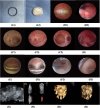Short-term reproductive outcomes analysis and prediction of the modified uterine stent treatment for mild to moderate intrauterine adhesions: experience at a single institution
- PMID: 38654192
- PMCID: PMC11036709
- DOI: 10.1186/s12905-024-03098-9
Short-term reproductive outcomes analysis and prediction of the modified uterine stent treatment for mild to moderate intrauterine adhesions: experience at a single institution
Abstract
Background: To evaluate the efficacy of modified uterine stent in the treatment of mild-to-moderate intrauterine adhesions and explore the relative indicators affecting prognosis prediction.
Methods: A total of 115 patients with mild-to-moderate intrauterine adhesions received a modified uterine stent placement after hysteroscopy adhesiolysis. The second-look hysteroscopy operated after 3 months surgery, and the third-look hysteroscopy operated after 6 months surgery if necessary. The stent was removed when the cavity shape was repaired, then the reproductive outcomes were followed up one year.
Results: Menstrual blood volume, endometrial thickness and volume had increased significantly after 3 months surgery. The rates of cavity repaired were 86.96% (100/115) after 3 months surgery and 100% (115/115) after 6 months surgery cumulatively. Endometrial thickness after 3-months surgery was positively associated with uterine cavity shape repaired (P<0.01). The receive operating characteristic (ROC) curve showed the rate of uterine cavity shape repaired predicted by the model was 0.92, based on the endometrial thickness after 3-months surgery. The rate of pregnancy was 86.09% (99/115) in one year, while the rate of miscarriage accounted for 26.26% (26/99). The median time interval between stent removal and subsequent conception was 3 months. It showed adhesion recurrence was the risk factor for subsequent pregnancy (P<0.01).
Conclusions: A modified uterine stent placement under hysteroscopy was an effective approach for mild-to-moderate intrauterine adhesions, which is easy to operate and worthy for clinical promotion. Endometrial thickness measured by ultrasonography probably has predictive value in adhesion recurrence and subsequent pregnancy.
Trial registration: ChiCTR2100051524. Date of registration (retrospectively registered): 26/09/2021.
Keywords: Hysteroscopy; Intrauterine adhesions; Modified uterine stent; endometrial thickness; reproductive outcomes.
© 2024. The Author(s).
Conflict of interest statement
The authors declare no competing interests.
Figures







Similar articles
-
Effects of early second-look hysteroscopy combined with intrauterine balloon dilatation on reproductive outcomes for women with intrauterine adhesions.Int J Gynaecol Obstet. 2020 May;149(2):192-196. doi: 10.1002/ijgo.13108. Epub 2020 Feb 21. Int J Gynaecol Obstet. 2020. PMID: 32012261
-
Intrauterine administration of G-CSF for promoting endometrial growth after hysteroscopic adhesiolysis: a randomized controlled trial.Hum Reprod. 2022 Apr 1;37(4):725-733. doi: 10.1093/humrep/deac023. Hum Reprod. 2022. PMID: 35147195 Clinical Trial.
-
Observation of the Auxiliary Treatment Effect of Low-Frequency Nerve Therapy Instrument after Hysteroscopy for Moderate and Severe Intrauterine Adhesions Based on Intelligent Medical Treatment.J Healthc Eng. 2022 Apr 11;2022:2929800. doi: 10.1155/2022/2929800. eCollection 2022. J Healthc Eng. 2022. Retraction in: J Healthc Eng. 2022 Nov 23;2022:9790264. doi: 10.1155/2022/9790264. PMID: 35449839 Free PMC article. Retracted. Clinical Trial.
-
Hysteroscopy for treating subfertility associated with suspected major uterine cavity abnormalities.Cochrane Database Syst Rev. 2018 Dec 5;12(12):CD009461. doi: 10.1002/14651858.CD009461.pub4. Cochrane Database Syst Rev. 2018. PMID: 30521679 Free PMC article.
-
Intrauterine adhesions.Obstet Gynecol Clin North Am. 1995 Sep;22(3):491-505. Obstet Gynecol Clin North Am. 1995. PMID: 8524533 Review.
Cited by
-
Retrospective Analysis of Prognostic Factors and Pregnancy Outcomes in Patients with Moderate-to-Severe Intrauterine Adhesions Following Hysteroscopic Adhesiolysis and Modified Intrauterine Stent Intervention.Ther Clin Risk Manag. 2025 Jun 21;21:929-939. doi: 10.2147/TCRM.S511425. eCollection 2025. Ther Clin Risk Manag. 2025. PMID: 40567858 Free PMC article.
References
-
- Fritsh H. Ein Fall von volligem Schwund ser Gebarmutterhohle nach Auskratzung. Zentralbl Gynaekol. 1894;18:1337–1342.
-
- Smikle C, Yarrarapu SNS, Khetarpal S. Asherman Syndrome. 2023 Jul 24. In: StatPearls. Treasure Island (FL): StatPearls Publishing; 2024 Jan–. PMID: 28846336. - PubMed
-
- Hong W, Wu Z, Li L, Wang B, Li X. Intrauterine adhesions treated with hysteroscopic adhesiolysis and subsequent obstetric outcome: A retrospective matched cohort study. BJOG. 2024 10.1111/1471-0528.17793. Epub ahead of print. PMID: 38418403. - PubMed
Publication types
MeSH terms
Grants and funding
LinkOut - more resources
Full Text Sources
Medical

